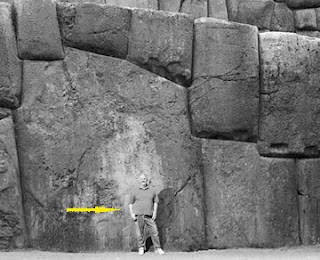 Notice my height compared to the size of the stone behind me
Notice my height compared to the size of the stone behind me When I was a young man, the stone walls found in Peru that were so perfectly joined without mortar that one could not stick a piece of paper or knife blade between them, elicited a great deal of interest. Books were written about these walls, coffee table picture books were sold everywhere. Scientists marveled at the archaeological significance of the work, and engineers were awed by the construction of these huge stones. I recall specifically that there was more than one work about how aliens had used sound waves to carry the blocks from distances to their construction sites and carved them into perfect fit with advanced technology.

Obviously, there needed some explanation of a work that baffled the best and brightest of our professionals. How could any prehistoric society using stone or copper tools, carve such perfect fits in huge stones that weighed many tons? No one had a plausible answer. Even today, decades later, this achievement still baffles the best and brightest, even with such advanced technology as we have today.
While the stone work in Mesoamerica is magnificent and shows a prehistoric expertise unequalled almost anywhere—it does not come close to the stonework of the ancient Peruvian, which was built as much as a thousand years prior to that found in Mesoamerica.
Who built these magnificent walls and buildings in Peru? Who had the knowledge of math and construction techniques in the prehistoric world to accomplish such things? These are not just stone carvings of tremendous sizes, large carved heads, or the fabulous, but small-stone stacked blocks of Mesoamerican temples. In the cases of the oldest Peruvian stonework, they are accomplishments of the most advanced builders, masons, and carvers—their like with anything less than modern equipment and tools, unmatched anywhere in the world, even today. Some of the stone blocks weighed 440 tons (equivalent to 600 full-size cars), other stones even larger, with most between 100 and 150 tons. At Tiahuanaco, these huge sized stones were quarried and brought from ten miles away.

But within the “Nephi code,” that is, the writings of Nephi, we find plausible answers. For Nephi had more than just prehistoric stone and copper tools (1 Nephi 17:9), was tutored and instructed by the Lord in building techniques (1 Nephi 18:1-3), and taught his people how to build buildings, work with wood, iron, and ore (2 Nephi 5:15). He built a temple to rival Solomon’s, considered one of the great works of that era (2 Nephi 5:16). Is it any wonder the Nephites could have built this magnificent stonework “not after the manner of men” found all over Peru and the Andes?




There were three groups of such elegant building in the B.C. era, one was Egypt, the other two were in the Western Hemisphere, Peru and Mesoamerica. I think I read somewhere that Peru was far older than Mesoamerica in such building, but both areas were similar in concept to that of Egypt. The only other area I know of with pyramids or step-pyramids was in Mesopotamia about the time the Jaredites were there
ReplyDeleteI have really enjoyed your posts. They make a lot of sense. You read what others have said about their central american area and all it is is so much supposition, and rarely associated with scripture from the bom as you do or any other source of importance and believability beyond people who have a vested interest in central america. I hope you will continue to post information like you have. It is most enlightening to hear from sources not connected to the bom who agree with your views
ReplyDeleteWell said, Karl. I couldn't agree more. This is a great site for learning...not of people's opinions...but of factual knowledge about the areas mentioned in the Book of Mormon. I especially loved the last one about the currents and the measurments being made even today to make sure where the currents flow. Doing a little amateur sailing, I understand the need to use the winds and currents...something others seem to completely ignore.
ReplyDeleteYou wrote "But within the “Nephi code,” that is, the writings of Nephi" Interesting. I did not realize why you named this the NephiCode.com, but now I do. I assume you mean that Nephi left us clues to things by the way he wrote about the geography, ore, flora and fauna of the land of promise. I need to re-read my BOM again with that thought in mind. Thanks for the "clue"
ReplyDeleteJackson--you should get his books. This is all made perfectly clear. Besides, they are not only great reading, but filled with more knowledge than a college major
ReplyDeleteJackson: It is not that Nephi left us clues, it is that his writing, if we really read it as written, tells us what we need to know to learn where they went and where they landed and what they found there. We have taken liberty with the "clue bit" for the fun of the concept. Remember, that Nephi edited Lehi's writings from the large plates--what else was said about the locations is not known to us--but Nephi left us enough information to figure it out without too much effort--what we are calling clues.
ReplyDelete